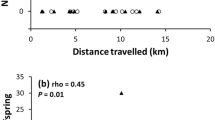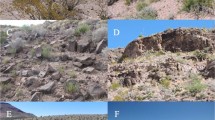Abstract
Males in scramble competitive species that are in better condition are expected to have better endurance and thus be able to travel farther during bouts of mate searching. In this study, we use radio telemetry to field test the hypothesis that male Cook Strait giant weta Deinacrida rugosa (Orthoptera: Anostostomatidae) in better body condition accrue more mates because they are more mobile (i.e., travel farther per night in mate searches). Our study showed that males travel significantly farther, on average, each night than females and that individuals exhibit consistent travel distances and body conditions across days. As predicted, we found that male mating success was influenced by body condition and travel distance; however, contrary to expectation, both variables were negatively related to mating success. Contrary to expectation, we did not find an effect of body condition on travel distance in either sex nor did we find that increased nightly travel was more costly to body condition. We suggest that males in our study population that are lighter for their body weight (i.e., poorer condition) might be superior in sprints for nearby females. Consequently, these successful males will then reduce their movement because females are relatively sedentary. If a male is unable to acquire a female that is nearby, he is likely then obligated to engage in a prolonged mate search that is generally unsuccessful.
Significance statement
Males in better body condition are expected to be more successful in scrambles for mates because they should have better endurance and thus be able to travel farther while mate searching. Our field test found, as predicted, that the mating success of male Cook Strait giant weta Deinacrida rugosa (Orthoptera: Anostostomatidae) was influenced by body condition and travel distance; however, contrary to expectation, both variables were negatively related to mating success. Contrary to expectation, we found that nightly mate searching had no effect on body condition and vice versa. Our study presents rare evidence of male mating success in a scramble competitive species being affected by body condition and mate-searching effort (as measured by travel distance) albeit in a manner opposite to prediction.



Similar content being viewed by others
Data availability
The data used in this study are available at the Open Science Framework: https://doi.org/10.17605/OSF.IO/FVH3M.
References
Andersson MB (1994) Sexual selection. Princeton University Press, Princeton, NJ
Baena M, Macı́as-Ordóñez R (2012) Phenology of scramble polygyny in a wild population of chrysomelid beetles: the opportunity for and the strength of sexual selection [corrected]. PLoS One 7:e38315
Baena ML, Macı́as-Ordóñez R (2015) Mobility and mating frequency in the scramble competition polygyny of a chrysomelid beetle. Behavioral Ecology 26:416–424
Banks MJ, Thompson DJ (1987) Lifetime reproductive success of females of the damselfly Coenagrion puella. J Anim Ecol 56:815–832
Biedermann R (2002) Mating success in the spittlebug Cercopis sanguinolenta (Scopoli, 1763) (Homoptera, Cercopidae): the role of body size and mobility. J Ethol 20:13–18
Blanckenhorn WU, Preziosi RF, Fairbairn DJ (1995) Time and energy constraints and the evolution of sexual size dimorphism—to eat or to mate. Evol Ecol 9:369–381
Cordero Rivera A, Egido Pérez F, Andres J (2002) The effect of handling damage, mobility, body size, and fluctuating asymmetry on lifetime mating success of Ischnura graellsii (Rambur)(Zygoptera: Coenagrionidae). Odonatologica 31:117–128
Dechaume-Moncharmont F-X, Brom T, Cézilly F (2016) Opportunity costs resulting from scramble competition within the choosy sex severely impair mate choosiness. Anim Behav 114:249–260
Department of Conservation of New Zealand. New Zealand threat classification system. https://nztcs.org.nz/home. Accessed: 28 October 2022
Dickinson JL (1992) Scramble competition polygyny in the milkweed leaf beetle: combat, mobility, and the importance of being there. Behav Ecol 3:32–41
Foellmer M, Fairbairn D (2005) Selection on male size, leg length and condition during mate search in a sexually highly dimorphic orb-weaving spider. Oecologia 142:653–662
Foley A, Hewitt D, DeYoung R et al (2018) Reproductive effort and success of males in scramble-competition polygyny: evidence for trade-offs between foraging and mate search. J Anim Ecol 87:1600–1614
Glaudas X, Rodriguez-Robles JA (2011) Vagabond males and sedentary females: spatial ecology and mating system of the speckled rattlesnake (Crotalus mitchellii). Biol J Linn Soc 103:681–695
Glaudas X, Rice S, Clark R, Alexander G (2020) Male energy reserves, mate-searching activities, and reproductive success: alternative resource use strategies in a presumed capital breeder. Oecologia 194:415–425
Gyulavári HA, Therry L, Dévai G, Stoks R (2014) Sexual selection on flight endurance, flight-related morphology and physiology in a scrambling damselfly. Evol Ecol 28:639–654
Hartig F (2022) DHARMa: residual diagnostics for hierarchical (multi-level / mixed) regression models. R package version 0.4.6. http://florianhartig.github.io/DHARMa/
Herberstein ME, Painting CJ, Holwell GI (2017) Scramble competition polygyny in terrestrial arthropods. In: Naguib M, Podos J, Simmons LW et al (eds) Advances in the study of behavior. Elsevier, Cambridge, Massachusetts, pp 237–295
Hill GE (2011) Condition-dependent traits as signals of the functionality of vital cellular processes. Ecol Lett 14:625–634
Kelly CD (2006a) Resource quality or harem size: what influences male tenure at refuge sites in tree weta (Orthoptera: Anostostomatidae). Behav Ecol Sociobiol 60:175–183
Kelly CD (2006b) The relationship between resource control, association with females and male weapon size in a male dominance insect. Ethology 112:362–369
Kelly CD (2015) Male-biased sex ratios and plasticity in post-insemination behaviour in the New Zealand stick insect Micrarchus hystriculeus. Behaviour 152:653–666
Kelly CD (2020) Sexual selection on the size and shape of morphological traits in the japanese beetle (Popillia japonica). Behav Ecol 31:1073–1083
Kelly CD, Gwynne DT (2016) The effect of condition on mate searching speed and copulation frequency in the Cook Strait giant weta. Behav Ecol Sociobiol 70:1403–1409
Kelly CD, Gwynne DT (2017) Do male Cook Strait giant weta prudently allocate sperm. J Insect Behav 30:308–317
Kelly CD, Bussière LF, Gwynne DT (2008) Sexual selection for male mobility in a giant insect with female-biased size dimorphism. Am Nat 172:417–423
Kelly CD, Bussiere LF, Gwynne DT (2010) Pairing and insemination patterns in a giant weta (Deinacrida rugosa: Orthoptera; Anostostomatidae). J Ethol 28:483–489
Kelly CD, Tawes B, Worthington A (2014) Evaluating indices of body condition in two cricket species. Ecol Evol 4:4476–4487
Lane J, Boutin S, Speakman J, Humphries M (2010) Energetic costs of male reproduction in a scramble competition mating system. J Anim Ecol 79:27–34
Madsen T, Shine R, Loman J, Håkansson T (1993) Determinants of mating success in male adders, Vipera berus. Anim Behav 45:491–499
Marmet J, Pisanu B, Chapuis J-L et al (2012) Factors affecting male and female reproductive success in a chipmunk (Tamias sibiricus) with a scramble competition mating system. Behav Ecol Sociobiol 66:1449–1457
McIntyre M (2001) The ecology of some large weta species in New Zealand. In: Field LH (ed) The biology of wetas, king crickets and their allies. CABI Publishing, Wallingford, UK, pp 225–242
Moya-Laraño J, Halaj J, Wise DH (2002) Climbing to reach Romeo should be small. Evolution 56:420–425
Moya-Laraño J, El-Sayyid MT, Fox C (2007) Smaller beetles are better scramble competitors at cooler temperatures. Biol Lett 3:475–478
Parker G, Pizzari T (2010) Sperm competition and ejaculate economics. Biol Rev Camb Philos Soc 85:897–934
Peig J, Green AJ (2009) New perspectives for estimating body condition from mass/length data: the scaled mass index as an alternative method. Oikos 118:1883–1891
Pinheiro J, Bates D, DebRoy S, et al (2022) Nlme: linear and nonlinear mixed effects models. R package version 3.1-160. https://CRAN.R-project.org/package=nlme
Pitnick S, Markow TA (1994) Male gametic strategies: sperm size, testes size, and the allocation of ejaculate among successive mates by the sperm-limited fly Drosophila pachea and its relatives. Am Nat 143:785–819
R Core Team (2019) R: a language and environment for statistical computing. Austria, Vienna
Richards AM (1973) A comparative study of the biology of the giant wetas Deinacrida heteracantha and D. fallai (Orthoptera: Henicidae) from New Zealand. J Zool 169:195–236
Schwagmeyer P (1988) Scramble-competition polygyny in an asocial mammal: male mobility and mating success. Am Nat 131:885–892
Schwagmeyer P, Woontner S (1986) Scramble competition polygyny in thirteen-lined ground squirrels: the relative contributions of overt conflict and competitive mate searching. Behav Ecol Sociobiol 19:359–364
Stoffel MA, Nakagawa S, Schielzeth H (2017) RptR: repeatability estimation and variance decomposition by generalized linear mixed-effects models. Methods Ecol Evol 8:1639–1644
Stringer I, Field LH (2001) The reproductive biology and the eggs of New Zealand Anostostomatidae. In: The Biology of Wetas, King Crickets and their Allies. CABI Publishing, Wallingford, UK, pp 379–397
Tazzyman S, Pizzari T, Seymour R, Pomiankowski A (2009) The evolution of continuous variation in ejaculate expenditure strategy. Am Nat 174:E71-82
Thornhill R, Alcock J (1983) The evolution of insect mating systems. Harvard University Press, Boston, MA
Vencl FV, Carlson AD (1998) Proximate mechanisms of sexual selection in the firefly Photinus pyralis (Coleoptera: Lampyridae). J Insect Behav 11:191–207
Vitousek MN (2009) Investment in mate choice depends on resource availability in female Galápagos marine iguanas (Amblyrhynchus cristatus). Behav Ecol Sociobiol 64:105–113
Watts C, Stringer I, Thornburrow D, MacKenzie D (2011) Are footprint tracking tunnels suitable for monitoring giant weta (Orthoptera: Anostostomatidae)? Abundance, distribution and movement in relation to tracking rates. J Insect Conserv 15:433–443
Watts C, Empson R, Thornburrow D, Rohan M (2012) Movements, behaviour and survival of adult Cook Strait giant weta (Deinacrida rugosa; Anostostomatidae: Orthoptera) immediately after translocation as revealed by radiotracking. J Insect Conserv 16:763–776
White DJ, Watts C, Allwood J et al (2017) Population history and genetic bottlenecks in translocated Cook Strait giant weta, Deinacrida rugosa: recommendations for future conservation management. Conserv Genet 18:411–422
Wilder SM, Raubenheimer D, Simpson SJ (2015) Moving beyond body condition indices as an estimate of fitness in ecological and evolutionary studies. Funct Ecol 30:108–115
Acknowledgements
We thank Em Oyston (New Zealand Department of Conservation, Marlborough Sound) for assistance while this research was being conducted on Maud Island.
Funding
This research was supported by Discovery Grants from the National Science and Engineering Research Council (NSERC) of Canada to CDK and DTG.
Author information
Authors and Affiliations
Corresponding author
Ethics declarations
Conflict of interest
The authors declare no competing interests.
Additional information
Communicated by D. J Hosken
Publisher's note
Springer Nature remains neutral with regard to jurisdictional claims in published maps and institutional affiliations.
Rights and permissions
Springer Nature or its licensor (e.g. a society or other partner) holds exclusive rights to this article under a publishing agreement with the author(s) or other rightsholder(s); author self-archiving of the accepted manuscript version of this article is solely governed by the terms of such publishing agreement and applicable law.
About this article
Cite this article
Kelly, C.D., Gwynne, D.T. Effect of body condition on mobility and mating success in a wild population of the scramble polygynous Cook Strait giant weta. Behav Ecol Sociobiol 77, 5 (2023). https://doi.org/10.1007/s00265-022-03278-3
Received:
Revised:
Accepted:
Published:
DOI: https://doi.org/10.1007/s00265-022-03278-3




